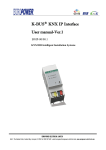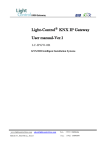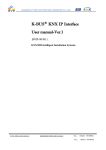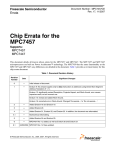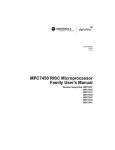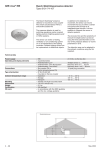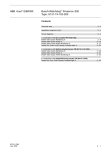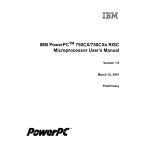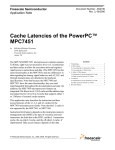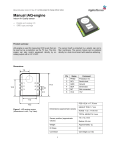Download IP/ KNX Converter User manual-Ver.1
Transcript
Guangzhou Video-Star Electronics Co., Ltd IP/ KNX Converter User manual-Ver.1 BTIC-01/00.1 http://www.video-star.com.cn Contents 1. Summary ----------------------------------------------------------------------------------------------------------------- 3 2. Technical Properties & Dimension and Circuit Diagram-------------------------------------------------- 4 3. 2.1 Technical data ---------------------------------------------------------------------------------------------------- 4 2.2 Dimension diagram ---------------------------------------------------------------------------------------------- 5 2.3 Circuit diagram --------------------------------------------------------------------------------------------------- 5 Parameter setting description in the ETS ---------------------------------------------------------------------- 6 3.1 Parameter window “IP settings” ------------------------------------------------------------------------------ 6 3.2 Parameter window “IP address” ------------------------------------------------------------------------------ 7 2 1. Summary The IP/ KNX converter is designed for an intelligent building control system, which is used to connect the KNX bus with the Ethernet network. It serves as an interface between KNX installations and IP networks. TCP telegrams can be transformed from other devices. TCP telegrams from other device on the Ethernet network can be converted to KNX telegrams via the converter, and send to the KNX bus to control KNX devices. The IP address of the IP/KNX converter is fixed. For operation an additional 30V DC supply is necessary. This manual provides detailed technical information about the IP/KNX Converter for users as well as assembly and programming details, and explains how to use the converter by the application examples. The IP/ KNX converter is a modular installation device. It can be installed in the distribution board on 35mm mounting rails according to EN 60 715. The device adopts an Ethernet RJ45 interface to connect with LAN network. The network interface can be operated with a transmission speed of 10/100Mbit/s Auto Sensing. The bus connection and auxiliary power supply connection are carried out via using EIB bus connection terminals. The IP/KNX converter is able to use the Engineering Tool Software ETS (ETS2 v1.3 or later) with a VD2/VD3 file to allocate the physical address and set the parameter. The functions of the IP/ KNX converter are summarized as follows: Support TCP/IP protocol, work in TCP server mode Pellucidly transfer all the telegrams Support up to10 TCP connections at the same time Send the TCP telegram to the KNX/EIB system, control the KNX device Monitor the KNX telegram, send them to all the clients connected Read respond telegram will send to the initiator only To read and write any data type defined in the KNX standard 3 2. Technical Properties & Dimension and Circuit Diagram 2.1 Technical data Power supply Connections Operation voltage 21-30V DC, via the EIB bus Current consumption, KNX <12mA Power consumption, KNX <360mW Auxiliary power supply 20-30V DC Auxiliary power consumption <2.5W EIB / KNX Via bus connection terminal (black/red) External power supply Via bus connection terminal (grey/yellow) RJ45 socket for10/100Base-T, IEEE 802.3 LAN network, Auto Sensing Operating and Programming LED and button For assignment of the physical address display LED Green flashing The device running indicator LED ON Network connection indicator LAN/LINK LED flashing Telegram traffic indicator Operation –5 °C ... + 45 °C Storage –25 °C ... + 55 °C Transport – 25 °C ... + 70 °C Ambient Humidity <93%, except condensation Design Modular installation device, on 35mm mounting rail Dimensions 90×36×64mm Weight 0.1KG Housing, colour Plastic housing, grey Temperature Application program IP/KNX converter Max. number of Max. number of Max. number of communication objects group address associations 0 0 0 4 2.2 Dimension diagram 2.3 Circuit diagram ① LED ON,indicate that network connect normally. ② LAN/LINK LED flashing, indicate that telegram traffic is ongoing. ③ Auxiliary power supply connection ④ LAN connection ⑤ Programming LED, LED red light up for assignment of physical address, LED green flashes for indicator of the device running normally. ⑥ Programming button ⑦ EIB /KNX bus connection 5 3. Parameter setting description in the ETS 3.1 Parameter window “IP settings” Parameter window “IP setting” is shown in fig. 3.2. Here can be set name and port number of the IP Convertor. Because IP converter and RS485 converter use the same product database, so before setting IP converter parameters, you must select devices first, as follow (fig.3.1): Fig 3.1 Choose device Fig.3.2 parameter window “IP settings” 6 Parameter “Device name (Max. 30 Char.)” The parameter defines the name of the IP converter to identify the device on the LAN. Here can entry a maximum of 30 characters in length. Currently, it is as spare parameter. Parameter “IP address assignment” The parameter indicates that the IP address assignment of the converter is fixed. The IP address can be assigned in the follow parameter window “IP address”, see fig. 3.2. Parameter “Port Number of the IP Convertor” The parameter defines the port number of the convertor, the port number of client devices must be same with the convertor, or else their communications will fail. 3.2 Parameter window “IP address” Parameter window “IP address” is shown in fig. 3.3. Here set network connection formation, such as IP address, Subnet mask and Default gateway. Fig 3.3 parameter window “IP address” Parameter “IP address” The parameter defines the IP address of the IP converter, the IP address is unique on the LAN, to avoid collide. Option: Byte x: 0…255 7 The IP address should be entered in a byte-by-byte manner, e.g. as follows for address 192.168.1.10: Byte1: 192 Byte2: 168 Byte3: 1 Byte4: 10 Parameter “Subnet mask” The parameter defines the subnet mask of the IP convertor. The subnet mask must be set to reflect the number and structure of the subnet. Option: Byte x: 0…255 In a small network the subnet mask 255.255.255.0 should be set as follows: Byte1: 255 Byte2: 255 Byte3: 255 Byte4: 0 Parameter “default gateway” The parameter defines the default gateway. The default gateway must be the same network segment with the IP address. Option: Byte x: 0…255 The default gateway 192.168.1.1 should be set as follows: Byte1: 192 Byte2: 168 Byte3: 1 Byte4: 1 8








